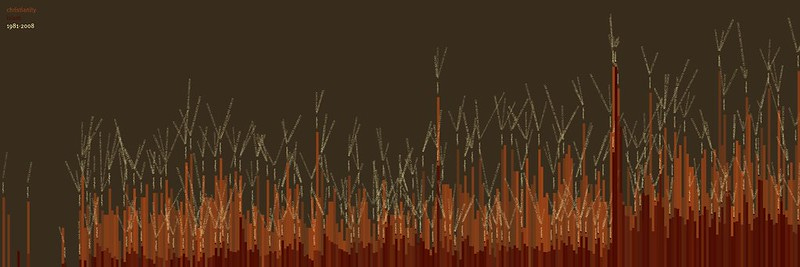People-centered data, with Jer Thorp
"Each of these numbers is tethered to something in the real world — and often those real world things are people."
PROGRAMMING NOTE: Slow Build is going on summer vacation next week, the week of August 23rd. We’ll be back at it the week of August 30th. Thanks for reading.
Jer Thorp (@blprnt) has been a “data-artist-in-residence” in the New York Times, an “emerging explorer” at National Geographic, and an “innovator-in-residence” at the Library of Congress. This spring, he came out his first book: “Living in Data: A Citizen’s Guide to a Better Information Future.”
The Canada-raised, Brooklyn-based Thorp has long gotten attention for turning data sets into striking works of art, like plotting connections in the Times’ archives, mapping the world’s travel patterns via “just landed” tweets, and perhaps most powerfully, building the tool behind the placement of names on Manhattan’s 9/11 Memorial.
Thorp says he benefited early on from not knowing the rules. With a background in generative art, not charts and graphs, Thorp was free to jump from data set to data set, treating them as fodder for visualizations that tested the boundaries of the form.

But over the years, says Thorp, he began to believe that his work was missing something, and eventually he came to what he calls a blunt and simple realization: “That the numbers aren’t just numbers, that each of these numbers is tethered to something in the real world — and often those real world things are people.”
And so Thorp began challenging himself to understand what’s behind the data — “swimming upstream into the data current,” he calls it. He imposed a rule: he wouldn't work with a data set about a place unless he’d been to that place, and wouldn't work with a data set involving people unless he’d met with that group of people.
Thorp’s book is, he says, both a documentation of that change in thinking and a call to others: “I do want to say to people who have felt a little uncomfortable about the work they're doing, 'Hey, maybe you're uncomfortable for the same reasons I was.’"
It was one of Thorp’s early explorations upstream to the people and places behind data that, in 2014, found him in a river in Botswana’s Okavango Delta, facing off with a hippopotamus in the scene that opens the book.
(This interview has been edited for length and clarity.)
Scola: After the hippo attack, you used the data collected by a heart-rate monitor you were wearing to produce an audio recreation of what your body was experiencing going through it. While you were being charged, were you thinking, “This is going to make a great piece of art?”
No way. I was thinking, “How am I gonna survive this?” We were in pretty narrow waterways and the only kind of land were papyrus beds, which are not very easy to get onto. I don’t think I really considered that I was wearing the heart rate monitor until an hour later, when things had settled down.

You’ve said that after being in Botswana, you started thinking more about indigenous data sovereignty, and the notion that people with deep ties to a place have a right to shape how data from there gets collected and used. How did that inform the “By the Laws of the Nation” visualization you have in the book, which shows where data centers from Apple, Amazon, Facebook, and Google overlap with tribal nations in the U.S.?
Data sovereignty is something that corporations can take advantage of, because they play by whatever rules the country that they're hosting the data in assigns to them. The cloud is the cloud, and you can pick and choose: “I want to use these laws to my advantage,” so you can move data to another country where they’re adhering to what’s more convenient for you.
It started with a question that I asked myself: “Okay, what are the nations and territories in which those giant data centers are sitting?” Because most of them are in these wide open areas in the American south and west, and those are places that in many cases have a lot of traditional meaning.
I guess I was imagining a future where indigenous nations had more control over those big, sprawling data centers that are built in the center of their land, and what that would mean from an ownership perspective.

Along those lines of ownership, I was intrigued by what you write in the book about what’s called the “meaningful adjacencies” that factored into the layout of names on the 9/11 Memorial. The idea there was to place the names of people connected to one another in their lives next to or near to one another. You say that as you worked on figuring out the best way to display those names, here and there you Googled the people behind them, and found that there seemed to be a correlation between adjacency requests and the sort of work people did, so that, say, CEOs had more adjacency requests made on their behalf than maintenance workers did.
It made me wonder — did the people who were the subject of fewer adjacency requests actually have fewer relevant adjacencies? Or instead did their next of kin and others in their lives not have the time or interest in making those requests? Or was it that those people felt less ownership over how their loved ones would be represented in that data?
I don’t know that it’s something that can be neatly disentangled. [But] what you can see with the memorial is that the more your job pays, the more likely you are to have more of those connections.
Some of that has to do with the very simple fact that these jobs that pay more tend to be jobs that people have been in for longer and that involve more social activity — meetings, for example – whereas the jobs that pay less — custodial jobs, food service, etc. — tend to involve less time [in the same positions]. So that is a pattern that exists; that’s definitely true. But what we see in the data is a sparseness that I don’t believe is totally coincidental.
That discussion was not meant to be an indictment of the way that memorial was put together, but rather [about] a realization that what I was seeing 11, 12 years ago and what I’m seeing now are very different. I didn’t have the tools to look critically at that data set that I do now. It was the first time for me that data became real people.
By the time the data set arrives to you — this one was delivered by FedEx, on a hard drive — so much has happened. In that case ten years had happened.
Now, if I had been doing the same job, I the first thing that I would have done was spent a lot more time trying to understand how that hard drive ended up on my desk. But they probably wouldn’t have wanted me to do the job, because I would have been too much of a pain in the ass, right?
A key part of your thinking now seems to be that people working with data should do just that: put the time and effort into figuring out exactly where the data came from, and the implications of that history. But is that realistic in the work of, say, someone doing data visualizations at a news organization?
It’s not something that I think would work for anybody. I’m not suggesting that journalists in a newsroom who are doing the data work have to go [to the source of the data]. But you still need to ‘go’ to those places, whether it’s physically to go there or to make the time to understand the thing you’re representing better than you already do.
Part of the appeal of data work, I think, is that you don’t have to talk to people. [Laughs.] Sometimes I think this whole era of ‘big data’ was sort of a trillion-dollar endeavor to not have to talk to people, to try to be able to glean from the data what you might otherwise glean from human interaction.
So how exactly do you change that in practice?
The idea from the book that I think is usable on a day-to-day basis is understanding that data is not a thing, it’s a part of a system. And you build the capacity to, any time you see data, understand how it runs backwards.
A big part of what anybody can take from the book is the reminder that the ways we think about data, even the language we use to talk about data, have been written for us. We only have one imaginary about what data can do. And that’s a whole story that has largely been told by a group of people working in a small set of universities in North America.
What I wanted to do is give people an avenue to step outside of that a little bit. Everybody is caught in this current. We need to find ways to get out of it for a moment, so we don’t spend so much time of our time paddling and can think about where we might want to go if we had the choice to go somewhere else.
Get Jer Thorp’s “Living in Data” here.
People-centered productivity
You know that here at Slow Build we love to talk about the tools people use to do their work. Thorp shares some of his:
“Even the mention of the term productivity tool gives me anxiety. [Laughs.] I don't know that I have very good productivity tools. I'll talk specifically about writing though. I use an app called Scrivener, which is amazing. People often complain about it being too hard to use and there is a little bit of a learning curve, but I couldn't have written the book without it.
And then the other thing that I did when I was writing the book was that I used three-by-five index cards. Whenever I had an idea or I came upon a quote when I was reading a book, I would write it on the index card. Then I had this big plastic box made for keeping photos, and I put all the index cards in that box. I color-coded them by whether they were an idea or a question or a reference. I ended up with all these cards in the box, which was really useful for me.
I'm a pencil-paper kind of person. There’s something beautiful about an index card. It's just like the right amount of space. Even if you have a couple sentences on there, it feels full and you can go put it in the box. That was something I was really satisfied with.”





